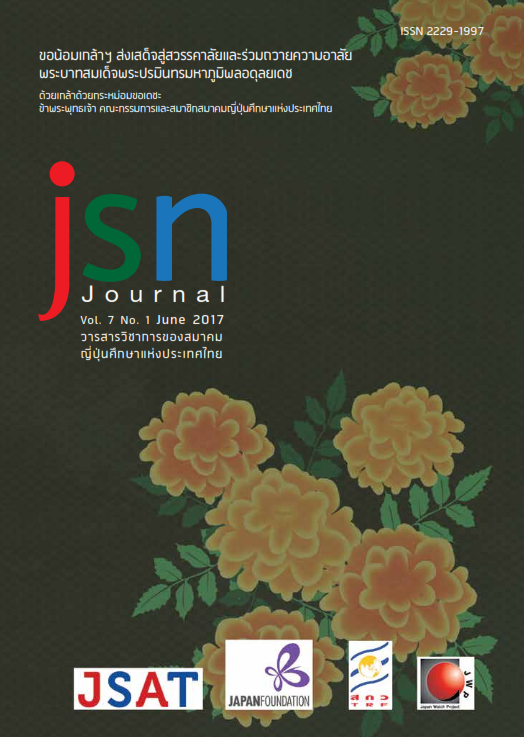Transition of Japanese Social Values Since World War II: A Generational Theory Approach
Main Article Content
Abstract
Since the surrender of Japan, which brought World War II to a close, and the subsequent occupation of Japan by the U.S., a myriad of changes in Japan’s economy, society, and culture have occurred. Accordingly, several researchers have attempted to explain these changes, particularly from historical and economic perspectives; however, few researchers have focused on the transformation of Japanese social values from the post-war period to the present. By gathering a range of primary and secondary sources (e.g., books, research papers, and newspapers), this paper aims to analyze the transition of Japanese social values based on generational theory. By separating the Japanese into five generations—the Yakeato generation, the Dankai generation, the Shinjinrui generation, the Dankai Junior generation, and the Satori (Yutori) generation—it was revealed that Japanese social values have been changing to conform to the Western democratic model, while conservatism, which has been a Japanese stereotype, has become less supported.
Article Details
ข้อความและข้อคิดเห็นต่างๆ ในบทความเป็นของผู้เขียนบทความนั้นๆ ไม่ใช่ความเห็นของกองบรรณาธิการหรือของวารสาร jsn Journal
References
Livedoor. (2014). 「団塊の世代、ゆとり世代...○○世代の特徴まとめ」 Retrieved fromhttp://news.livedoor.com/article/detail/9442178
NHK 放送文化研究所 (NHK Broadcasting Culture Research Institute). (2008). 『現代社会とメディア・家族・世代』 新曜社: 東京.
NHK 放送文化研究所 (NHK Broadcasting Culture Research Institute). (2015). 『現代日本人の意識構造』 NHK ブックス: 東京.
市川孝一(Ichikawa Koichi). (2003). 「若者論の系譜―若者はどう語られたか」. 『人間科学研究』 vol. 25, 123-130.
岡本洋一 (Okamoto Yoichi). (2011). 「戦後日本における世代形成~消費社会と世代」 『同志社社会学研究』 vol. 15, 43-56.
岩間夏樹 (Iwama Natsuki). (1995). 『戦後若者文化の光芒』日本経済新聞社: 東京.
久我尚子 (Kuga Naoko). (2012).「消費離れの今どきの若者たち、消費牽引の鍵は」ニッセイ基礎研究所、Retrieved from http://www.nli-research.co.jp/report/detail/id=39796?site=nli
国土交通省 (Ministry of Land, Infrastructure, Transport and Tourism). (2013).「国土交通白書」. 東京. Retrieved from http://www.mlit.go.jp/hakusyo/mlit/h24/hakusho/h25/
小谷敏 (Kotani Satoshi). (1998). 『若者たちの変貌:世代をめぐる社会学的物語』世界思想社: 東京.
児美川考一郎 (Komikawa Koichiro). (2013).「若者の消費行動に見る日本社会の未来形~モーレツからビューティフルへからの平凡な日常」『AD Study』. vol. 43, 10-15.
世代特徴ガイド (Sedai Tokuchou Guide). (2014). 「しらけ世代」、Retrieved fromhttp://sedainet.web.fc2.com/sirakesedai.html
田村俊則(Tamura Toshinori). (2012)「今どきの若者の特徴と背景~ゆとり世代を戦力化するために~」『産業セミナー』 大阪経済大学.
中野収 (Nakano Osamu). (1986). 『現代史のなかの若者』 三省堂: 東京.
長山 靖生 (Nagayama Yasuo). (2014). 『世代の正体: なぜ日本人は世代論が好きなのか』河出書房新社: 東京.
長浜功 (Nagahama Isao). (1970).「わが国における戦後世代論の展開と課題」『北海道大学教育学部紀要』. vol. 17, 1-15.
舞田敏彦 (Maita Toshihiko). (2016).「団塊、団塊ジュニア、ゆとり:3世代それぞれの人生軌跡」ニューズウィーク日本版 Retrieved from http://www.newsweekjapan.jp/stories/world/2016/01/post-4324_1.php
宮台真司 (Miyadai Shinji). (1994). 『制服少女たちの選択』 講談社:東京.
原田曜平 (Harada Yohei). (2013). 『さとり世代 盗んだバイクで走り出さない若者たち』角川書店: 東京.


